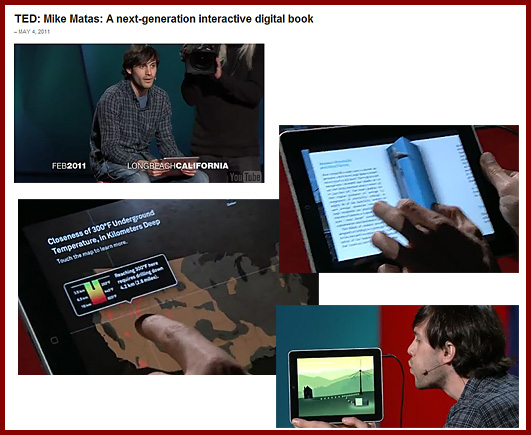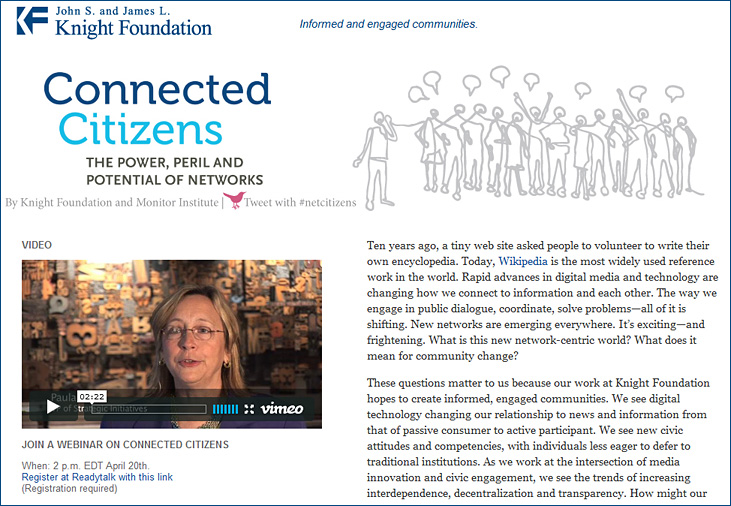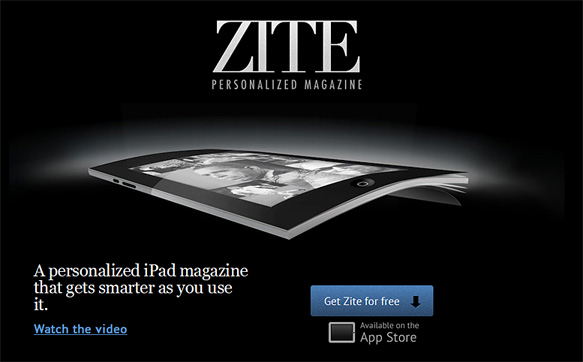Prototypes, visualizations take shape in Knight-Mozilla Learning Lab –– from PBS.org by Cody Shotwell
Data Visualization: Journalism’s Voyage West — from Stanford University
This visualization plots over 140,000 newspapers published over three centuries in the United States. The data comes from the Library of Congress’ “Chronicling America” project, which maintains a regularly updated directory of newspapers.
PressForward: A new project aims to rethink scholarly communication for the age of new media journalism — from niemanlab.org by Tim Carmody
Excerpt:
How journalists communicate has been radically changed by the Internet. Is it time for the academic world to catch up?
Today, the Roy Rosenzweig Center for History and New Media at George Mason University launches PressForward, a new discovery portal and publishing platform for scholarship and intellectual discussion on the web.

The big idea of PressForward is to create a digital-first alternative to the cumbersome mechanisms of traditional gatekeepers — academic journals — while keeping main benefits of print publication and peer review: their ability to concentrate a community’s attention around the best emergent writing and research. The project is bankrolled through a grant from the Alfred P. Sloan Foundation’s Digital Information Technology program.
Addendum on 6/28/11:
- Blogs Elbow Up to Journal Status in New Academic-Publishing Venture — from The Chronicle by Marc Parry
Five tips for emerging video journalists — over at the Innovative Interactivity blog by Paul Franz
Excerpt:
But there are a few skills that I strongly believe all budding video journalists should take note of as they begin their careers in multimedia production.
…
a) Get used to editing as if you were working for MTV. For example, TIME recently rolled out a new magazine feature called “Pop Chart,” which is tantamount to a kind of a whacky news round-up. Normally, these affairs can be boring time sinks that do not attract a whole lot of viewers or interest. But with a few editing tricks and changes to your style, they can become fun little shows that entertain as well as inform.
b) Start getting comfortable with your voice. Many pieces just won’t have all the content you require to have a single character narrate an entire piece. Purists will argue that not having enough A-roll is tantamount to laziness, but the realities of the job will force you to use your voice frequently as a narrative bridge.
From DSC:
Speed, personalization, interactivity driving advancements in media today — I would submit that these trends are true for education as well.
See:
- The Advent of ‘My’ Media — from wellesley.patch.com by Erich Archer
Excerpt:
Whether you’re talking about the future of television, news, or advertising, it’s all about speed, personalization, and interactivity. These three things are the driving considerations behind the advancement of all media today.
Say hello to Encyclo, our new encyclopedia of the future of news — from Nieman Journalism Lab by Joshua Benton
Addendum on 5/18 with a somewhat related item:
- 13 Alternative Ways to Consume Your News — from mashable.com
The story so far: What we know about the business of digital journalism — from Columbia Journalism School by Bill Grueskin, Ava Seave, & Lucas Graves
From DSC:
This type of report is relevant for many of the industries being disrupted by the Internet, including higher education. To me, the words “reinvent” and “innovate” came to my mind while reviewing this report.
Also see:
- The story so far: Will sponsored content and creative ads save digital journalism? — from Forbes.com by Nathaniel Parish Flannery
Mike Matas: A next-generation digital book (filmed March 2011)
About this talk
Software developer Mike Matas demos the first full-length interactive book for the iPad — with clever, swipeable video and graphics and some very cool data visualizations to play with. The book is “Our Choice,” Al Gore’s sequel to “An Inconvenient Truth.”
About Mike Matas
While at Apple, Mike Matas helped write the user interface for the iPhone and iPad. Now with Push Pop Press, he’s helping to rewrite the electronic book.
AP Interactive visualizes a future of stories that reach beyond text — from niemanlab.org
Excerpt:
Data visualization is “going through a kind of renaissance in journalism,” said Shazna Nessa, director of Interactive for the AP. What’s really behind the news collective’s uptick in graphics, she told me, is a kind of evolutionary change in journalism — one that’s reflected in the Interactive unit itself. Once a repository of charts and maps, the department is now creating what Nessa described as “comprehensive interactive stories,” and we can expect to see a lot more of them.
Interactive Journalism, The New York Times and Andrew DeVigal — from AdaptivePath.com by Sheryl Cababa
Excerpt:
The line between journalists and multimedia designers/technologists is blurring. At the NYT, they’re building tools and templates so it’s easier for reporters to actually build interactive pieces themselves. He used the ‘slideover photo’ interaction as an example. This template, when used for, say, the Japan earthquake, is poignant, as when they used it for the anniversary of the fall of the Berlin Wall. But it was also recently used to show models in last year’s runway show vs. this year’s runway show, and he felt that an interaction like that could lose its power and effectiveness (“are we now overusing this?”). So this is the sort of editorial gray area that they face as the tools become easier for the reporters themselves to use.
The newsonomics of oblivion — from the Nieman Journalism Lab by Ken Doctor
Excerpt:
The threat of oblivion should be a powerful motivator, and we now see — finally — after a decade of decline, its specter moving us away from incremental, “experimental” tests to a fundamental restructuring of the business of news.
From DSC:
(I don’t mean to be full of doom and gloom here. However, a healthy respect of the disruption being caused by technology is warranted here I believe.)
I couldn’t help but think of higher education as an industry when I reviewed this particular blog posting. Those of us working within higher education need to be highly aware of how other industries are dealing with the disruptions being caused by the Internet and other technologies. Why? Because the disruption has already begun within higher education.
From DSC:
Interesting if this same concept could be applied towards developing a personalized digital textbook that a student could build over time…and be assessed up what they came up with. Also the student could take the personalized textbook with them. Cool.
Also see:
- If You Like Flipboard, Check Out Zite – It’s Easier to Use — from ReadWriteWeb.com by Marshall Kirkpatrick
4/1/11 addendums:
- The iPad App That Went Too Far: Media Says Cease & Desist to Personalized Magazine Zite – from ReadWriteWeb.com by Marshall Kirkpatrick
- Major Media Companies Unite to Serve Cease-and-Desist Against iPad News Aggregator Zite — from Mashable.com by Lauren Indvik












